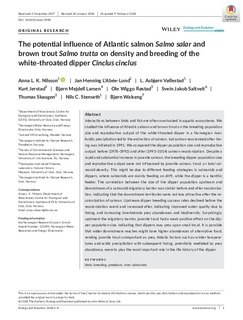The potential influence of Atlantic salmon Salmo salar and brown trout Salmo trutta on density and breeding of the white-throated dipper Cinclus cinclus
Nilsson, Anna; L'Abee-Lund, Jan Henning; Vøllestad, Leif Asbjørn; Jerstad, Kurt; Larsen, Bjørn Mejdell; Røstad, Ole Wiggo; Saltveit, Svein Jakob; Skaugen, Thomas; Stenseth, Nils Christian; Walseng, Bjørn
Journal article, Peer reviewed
Published version

Åpne
Permanent lenke
http://hdl.handle.net/11250/2494674Utgivelsesdato
2018Metadata
Vis full innførselSamlinger
- Publikasjoner fra CRIStin - NINA [2364]
- Scientific publications [1392]
Originalversjon
10.1002/ece3.3958Sammendrag
Interactions between birds and fish are often overlooked in aquatic ecosystems. We studied the influence of Atlantic salmon and brown trout on the breeding population size and reproductive output of the white-throated dipper in a Norwegian river. Acidic precipitation led to the extinction of salmon, but salmon recolonized after liming was initiated in 1991. We compared the dipper population size and reproductive output before (1978–1992) and after (1993–2014) salmon recolonization. Despite a rapid and substantial increase in juvenile salmon, the breeding dipper population size and reproductive output were not influenced by juvenile salmon, trout, or total salmonid density. This might be due to different feeding strategies in salmonids and dippers, where salmonids are mainly feeding on drift, while the dipper is a benthic feeder. The correlation between the size of the dipper population upstream and downstream of a salmonid migratory barrier was similar before and after recolonization, indicating that the downstream territories were not less attractive after the recolonization of salmon. Upstream dipper breeding success rates declined before the recolonization event and increased after, indicating improved water quality due to liming, and increasing invertebrate prey abundances and biodiversity. Surprisingly, upstream the migratory barrier, juvenile trout had a weak positive effect on the dipper population size, indicating that dippers may prey upon small trout. It is possible that wider downstream reaches might have higher abundances of alternative food, rending juvenile trout unimportant as prey. Abiotic factors such as winter temperatures and acidic precipitation with subsequent liming, potentially mediated by preyabundance, seem to play the most important role in the life history of the dipper. birds, breeding, predators, river, salmonids
